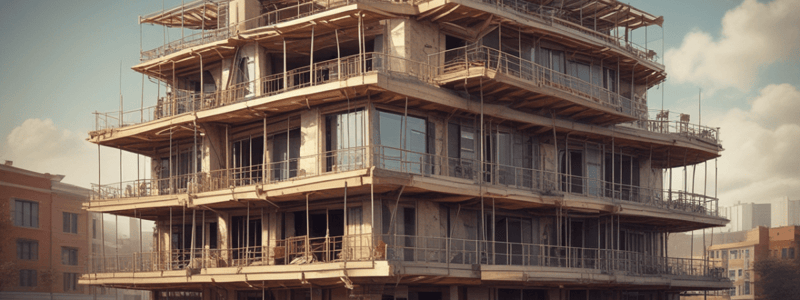Podcast
Questions and Answers
What type of structure is used in Example 2.9?
What type of structure is used in Example 2.9?
- Framed Structure
- Load bearing type structure (correct)
- Compound Wall
- Pitched Roof
What method is used in Example 2.10?
What method is used in Example 2.10?
- Compound Wall Method
- Long Wall and Short Wall Method
- Pitched Roof Method
- Centre Line Method (correct)
What type of structure is used in Example 2.11?
What type of structure is used in Example 2.11?
- Pitched Roof
- Framed Structure (correct)
- Compound Wall
- Load bearing type structure
What is estimated in Example 2.13?
What is estimated in Example 2.13?
What is the size of the common rafter in Example 2.13?
What is the size of the common rafter in Example 2.13?
What type of structure is used in Example 2.14?
What type of structure is used in Example 2.14?
What is the primary purpose of a detailed estimate?
What is the primary purpose of a detailed estimate?
What is the difference between a rough cost estimate and a detailed estimate?
What is the difference between a rough cost estimate and a detailed estimate?
What is the purpose of a supplementary estimate?
What is the purpose of a supplementary estimate?
What is the unit of measurement for earthwork in excavation?
What is the unit of measurement for earthwork in excavation?
What is the unit of payment for painting on doors and windows?
What is the unit of payment for painting on doors and windows?
What is the purpose of a bill of quantities?
What is the purpose of a bill of quantities?
What is the difference between administrative approval and technical sanction?
What is the difference between administrative approval and technical sanction?
What is the purpose of a schedule of rates?
What is the purpose of a schedule of rates?
What is the unit of measurement for brickwork in foundation and plinth?
What is the unit of measurement for brickwork in foundation and plinth?
What is the purpose of a preliminary estimate?
What is the purpose of a preliminary estimate?
What is the purpose of preparing a bill of quantities and abstract of cost for the given items of work?
What is the purpose of preparing a bill of quantities and abstract of cost for the given items of work?
What is the thickness of the brickwork in foundation and plinth in cement mortar?
What is the thickness of the brickwork in foundation and plinth in cement mortar?
What is the width of the foundation concrete for the Gang hut?
What is the width of the foundation concrete for the Gang hut?
What is the thickness of the damp proof course at plinth level?
What is the thickness of the damp proof course at plinth level?
What is the height of the room in the Gang hut?
What is the height of the room in the Gang hut?
What is the type of brickwork used in the foundation and plinth of the Gang hut?
What is the type of brickwork used in the foundation and plinth of the Gang hut?
What is the thickness of the brickwork in superstructure in cement mortar?
What is the thickness of the brickwork in superstructure in cement mortar?
What is the purpose of including the door and window sizes in the calculation?
What is the purpose of including the door and window sizes in the calculation?
Flashcards
Load Bearing Structures
Load Bearing Structures
Structures that rely on walls to support the weight of the building.
Centre Line Method
Centre Line Method
A method for estimating building quantities by using center lines.
Framed Structures
Framed Structures
Structures using beams and columns to support the building's weight.
Pitched Roof
Pitched Roof
Signup and view all the flashcards
Common Rafters
Common Rafters
Signup and view all the flashcards
Ridge Piece
Ridge Piece
Signup and view all the flashcards
Eaves Board
Eaves Board
Signup and view all the flashcards
Staircase Components
Staircase Components
Signup and view all the flashcards
Compound Wall
Compound Wall
Signup and view all the flashcards
Preliminary Estimate
Preliminary Estimate
Signup and view all the flashcards
Detailed Estimate
Detailed Estimate
Signup and view all the flashcards
Revised Estimate
Revised Estimate
Signup and view all the flashcards
Supplementary Estimate
Supplementary Estimate
Signup and view all the flashcards
Analysis of Rates
Analysis of Rates
Signup and view all the flashcards
Bill of Quantities
Bill of Quantities
Signup and view all the flashcards
Abstract of Cost
Abstract of Cost
Signup and view all the flashcards
Units of Measurement
Units of Measurement
Signup and view all the flashcards
Units of Payment
Units of Payment
Signup and view all the flashcards
Study Notes
Building Structures and Estimates
Load Bearing Type Structures
- Calculate details and abstract estimates for double roomed buildings using long wall and short wall methods and Centre Line Method.
- Calculate details and abstract estimates for single storied residential buildings with a certain number of rooms using Centre Line Method.
Framed Structures
- Calculate details and abstract estimates for single storied residential buildings with a certain number of rooms (Framed Structured type) using Centre Line Method.
- Calculate details and abstract estimates for two storied residential buildings with a certain number of rooms (Framed Structured type) using Centre Line Method.
Pitched Roof
- Estimate quantities of pitched roof components:
- Common rafter: 80x40mm
- Ridge piece: 120x200mm
- Eaves board: 20x300mm
Staircase
- Calculate quantities of staircase components using the given figure.
Compound Wall
- Calculate details and abstract estimates for Compound Wall using the given figure.
Estimation of Basement Steps
- Schedule of rates: a document that provides information on the rates of various items of work.
- Types of estimates:
- Preliminary estimate: a rough estimate prepared before the actual work begins.
- Detailed estimate: a detailed estimate prepared after the actual work begins.
- Revised estimate: an estimate prepared when there are changes in the original work.
- Supplementary estimate: an estimate prepared for additional work.
Analysis of Rates
- Analysis of rates: a process of breaking down the rate of an item of work into its component parts.
- Rates generally consist of:
- Labor cost
- Material cost
- Overhead cost
- Profit
Bill of Quantities and Abstract of Cost
- Bill of quantities: a document that lists out the quantities of each item of work.
- Abstract of cost: a document that summarizes the total cost of each item of work.
Units of Measurement and Payment
- Units of measurement:
- Earthwork: cubic meters
- Brickwork: square meters
- R.C.C. work: cubic meters
- Painting: square meters
- Units of payment:
- Earthwork: cubic meters
- Brickwork: square meters
- R.C.C. work: cubic meters
- Painting: square meters
Measurement of Items of Work
- Measurement of items of work:
- Painting on expanded metal: square meters
- Bending, placing, and binding reinforcement: kilograms
- Glass panes: number
- Pointing on walls: square meters
- Roofing with C.G.I. sheets: square meters
Distinctions
- Rough cost estimate vs. detailed estimate:
- Rough cost estimate: a rough estimate prepared before the actual work begins.
- Detailed estimate: a detailed estimate prepared after the actual work begins.
- Revised estimate vs. supplementary estimate:
- Revised estimate: an estimate prepared when there are changes in the original work.
- Supplementary estimate: an estimate prepared for additional work.
- Dismantling vs. demolition:
- Dismantling: the process of taking apart a structure.
- Demolition: the process of tearing down a structure.
- Administrative approval vs. technical sanction:
- Administrative approval: approval from the administration.
- Technical sanction: approval from the technical team.
- Sundries and supervision charges:
- Sundries: miscellaneous expenses.
- Supervision charges: charges for supervising the work.
Multiplying Factors
- Multiplying factors adopted in painting of various types of doors:
- Doors: 1.2
- Windows: 1.5
- Shutters: 2.0
Rules for Deduction
- Rules for deduction from plastering for opening in brick surfaces:
- Doors: 0.3 square meters
- Windows: 0.5 square meters
- Shutters: 0.7 square meters
Direct Cost and Overhead Cost
- Direct cost: the cost of labor and materials.
- Overhead cost: the cost of indirect expenses such as supervision, administration, and miscellaneous expenses.
Calculation of Quantities
- Calculation of quantities of wood work in a chowkhat of a door frame:
- 2.1 m x 1.2 m x 7.5 cm x 10 cm = 0.175 cubic meters
Studying That Suits You
Use AI to generate personalized quizzes and flashcards to suit your learning preferences.
Description
Calculate the details and abstract estimate for a double roomed and single storied residential building with load bearing type structure using the long wall and short wall method, and the centre line method.




